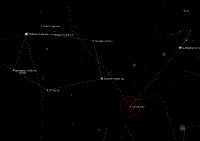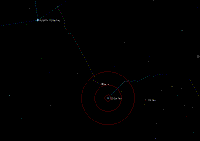M1 (The Crab Nebula, supernova remnant in Taurus)
280: Crab Nebula (M1) Photograph
M1, better known as the Crab Nebula, was the first object that Messier added to his catalog. Although some older sources categorize M1 as a Planetary Nebula, it’s more properly designated a Supernova Remnant (SNR). It’s the only SNR in Messier’s catalog, and the only SNR clearly visible as such in an amateur scope. M1 resulted from the supernova observed in Taurus on July 4, 1054 A.D. by Chinese astronomers. That supernova reached a magnitude of about –6, or four times brighter than Venus, and was visible during the day for 23 days. It remained a naked eye object at night for 653 days. That supernova was recorded by civilizations ranging from the Chinese to the Anasazi Indians in the American Southwest, but bizarrely no European record of it exists.
The SNR was first reported by Dr. John Bevis in 1731. While looking for the first predicted return of Comet Halley, Messier located M1 independently on August 28, 1758, at first thinking that it was a comet. Over the next two weeks, Messier found that the object had no apparent proper motion and so cataloged it as a fixed object on September 12, 1758. Here’s an excerpt from Messier’s original observation report:
“Nebula above the southern horn of Taurus, it doesn't contain any star; it is a whitish light, elongated in the shape of a flame of a candle, discovered while observing the comet of 1758. […] observed by Dr. Bevis in about 1731.”
The two weeks he spent tracking M1 in the belief that it was a comet changed Messier’s life. It was the reason both that he began searching for comets systematically, and the reason that he began compiling his famous catalog of objects that could be mistaken for comets. Messier later wrote of this experience:
The discovery of such a small Comet by four astronomers on the same day makes looking evidently how one has looked for them before me with telescopes crossing the sky, how I have done it since 1758, one would have known a well greater number which have escaped by their smallness of light; those which have been seen before 1758 had to appear to the unaided eye, or discovered by accident with telescopes employed for other observations, as is the nebula in the head of Aquarius [M2], discovered when observing the comet of 1746, by M. Maraldi; I discovered in the same way a nebula in the southern horn of the Bull [Taurus] on August 28, 1758, when observing the comet of that year; this nebula resembled the Comet in the form, the light and the size, it was this nebula which resembled them which gave me the first idea to search Comets with telescopes by crossing through the sky, and I have discovered a large number.
Although Messier compiled his catalog to help avoid confusing the objects he logged with comets, M1 was again confused with comet Halley when that comet returned in 1835. It was christened the "Crab" on the ground of a drawing made by Lord Rosse about 1844.
So M1, although it is by no means the most impressive of the Messier Objects, was the object that started it all.
290: M1 Telrad overview
M1 is easy to find, but it can be hard to see. Its visual magnitude is 8.40, but its surface brightness is only about 11.0. It’s a relatively small object, with an extent of about 8-by-4 minutes. The Astronomical League rates M1 as a “Challenge” object with 7X50 binoculars. Under dark skies, say up on the parkway, you may be able to see it faintly in 7X50 binoculars or a 50mm finderscope. But at Bullington or other sites with significant light pollution and haze, you probably won’t be able to see it at all until you get it into your eyepiece. I certainly have never gotten it in binoculars at Bullington, despite multiple attempts.
To find M1, begin by locating the constellation Taurus. Taurus is easy to find, because it sits in the center of the triangle formed by the Pleiades, Orion, and the pentagon of Auriga, from which the zeroth magnitude Capella blazes. Taurus itself has the first magnitude Aldebaran, so locating Taurus should never be a problem. Once you have yourself oriented to Taurus and Auriga, locate the star Alnath, which at magnitude 1.65 is quite prominent. Although Alnath is actually 112 Beta Tauri, it appears in the Pentagram of Auriga diagonally opposite Capella. From Alnath, locate the third-magnitude star 123 Zeta Tauri and center it in your Telrad.
300: M1 Telrad detail
M1 sits directly on the 2-degree circle just slightly to the Aldebaran side of the line that joins 123 Zeta Tauri to 112 Beta Tauri. Pivot your scope on that line to put 123 Zeta Tauri on the other side of the 2-degree circle, move the scope very slightly toward Aldebaran, and M1 is centered. It won’t be visible in your optical finder, but you should be able to see it as a faint fuzzy in your low-power eyepiece.
Once you have M1 centered in that eyepiece, change to a higher-power eyepiece to view the object. On larger scopes, you can use an eyepiece with a field of view as small as ¼ degree to good effect on this object. If you have a narrowband LPR filter and your scope is at least 8”, the filter can enhance the contrast and visible detail on this object.


